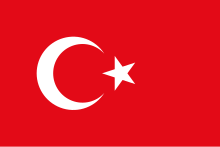Flag of Turkey: Difference between revisions
m robot Adding: id:Bendera Turki |
No edit summary |
||
| Line 12: | Line 12: | ||
The flag is described according to various [[legend]]s in the country, the most popular of which include: |
The flag is described according to various [[legend]]s in the country, the most popular of which include: |
||
* A reflection of the moon occulting a star, appearing in pools of blood after the [[Battle of Kosovo]], led to the adoption of the Turkish flag by Sultan [[Murad I]].[[Image:Kosovaflag.gif|thumb|300px|right| A simulation of Kosovo Battle. Date: 28 July 1389 Position: Lat: 43.41 , Long: 25.65]] |
|||
* A dream of the first Ottoman Emperor in which a crescent and star appeared from his chest and expanded, presaging the dynasty's [[fall of Constantinople|seizure of Constantinople]].[http://flagspot.net/flags/tr.html#mean] |
* A dream of the first Ottoman Emperor in which a crescent and star appeared from his chest and expanded, presaging the dynasty's [[fall of Constantinople|seizure of Constantinople]].[http://flagspot.net/flags/tr.html#mean] |
||
* A crescent and star were spotted on the night of the [[fall of Constantinople]] to [[Mehmet II]] in [[1453]]. |
* A crescent and star were spotted on the night of the [[fall of Constantinople]] to [[Mehmet II]] in [[1453]]. |
||
Revision as of 12:00, 4 June 2006

The flag of Turkey consists of a white crescent and star on a red background. The flag is called Ay Yıldız (Turkish for 'moon star').
The flag has a complex origin since it is an ancient design, being almost identical to the last flag of the Ottoman Empire.
Red is a prominent color in Turkish history, especially regarding the bloody battles of the Turkish War of Independence. The crescent and star, while generally regarded as Islamic symbols today, have for long been used in Asia Minor, quite before the advent of Islam. The flag was originally simply a crescent on a green field, but this was changed in 1793 when Sultan Selim III changed the background to red. In 1844, the star was added.
The shade of red used in the flag is approximated by Pantone 186, or RGB (227, 10, 23).
The flag is described according to various legends in the country, the most popular of which include:
- A dream of the first Ottoman Emperor in which a crescent and star appeared from his chest and expanded, presaging the dynasty's seizure of Constantinople.[1]
- A crescent and star were spotted on the night of the fall of Constantinople to Mehmet II in 1453.
- The most widely believed, however, tells of Mustafa Kemal Atatürk, the founder of the modern Turkish Republic, walking on a battlefield one night after a victorious battle in the Turkish War of Independence, and seeing the reflection of the star and crescent formation, in a large pool of blood on the rocky hill terrain of Sakarya.
Another theory regarding the flag dates it back to the Byzantine Empire. It states that a Crescent and Star were used as the symbol of the Greek city of Byzantion for centuries, and when the Ottomans took Constantinople, it was adopted as the symbol of the Ottoman Empire (the moon refers as Artemis, Goddess of hunting, while the star refers to the blessed virgin mary).
Legal Basis
The fundamentals of the Turkish Flag were laid down by Turkish Flag Law No. 2994 of May 29, 1936. Turkish Flag Regulation No. 2/7175 dated July 28, 1937, and Supplementary Regulation No. 11604/2 dated July 29, 1939, were enacted to describe how the flag law would be implemented. The Turkish Flag Law No. 2893 dated September 22, 1983, and Published in the Official Gazette on September 24, 1983, was promulgated six months after its publication. According to Article 9 of Law No. 2893, a statute including the fundamentals of the implementation was also published.
Construction

| Letter | Measure | Length |
|---|---|---|
| G | Width | 1 |
| A | Distance between the centre of the outer crescent and the seam of the white band | 1/2 G |
| B | Diameter of the outer circle of the crescent | 1/2 G |
| C | Distance between the centres of the inner and outer circles of the crescent | 0.0625 G |
| D | Diameter of the inner circle of the crescent | 0.4 G |
| E | Distance between the inner circle of the crescent and the circle around the star | 1/3 G |
| F | Diameter of the circle around the star | 1/4 G |
| L | Length | 1 ½ G |
| M | Width of the seam band | 1/30 G |
Note that the above specification is what is given by Turkey's flag law, according to Flags of the World. The number 1/3 appears to be inaccurate; the other figures imply that distance E is really 0.34875 G.
